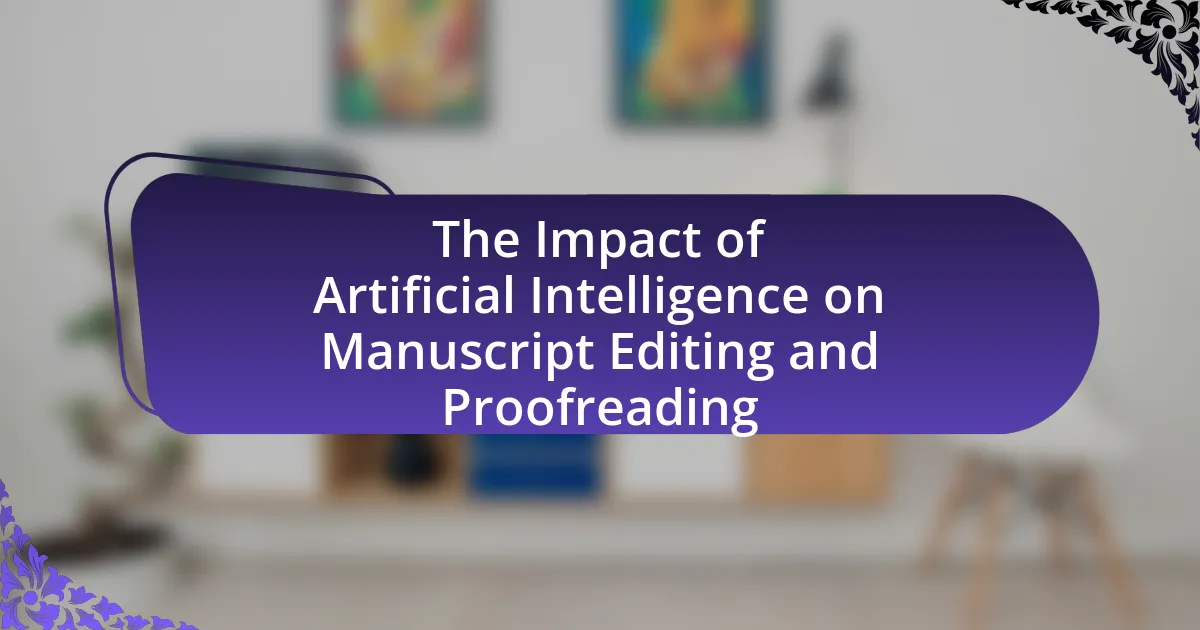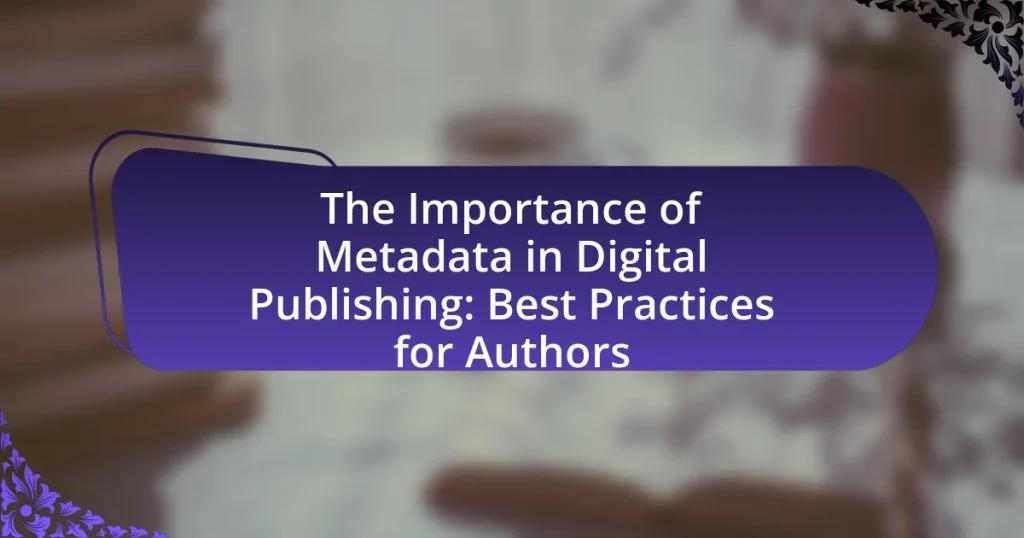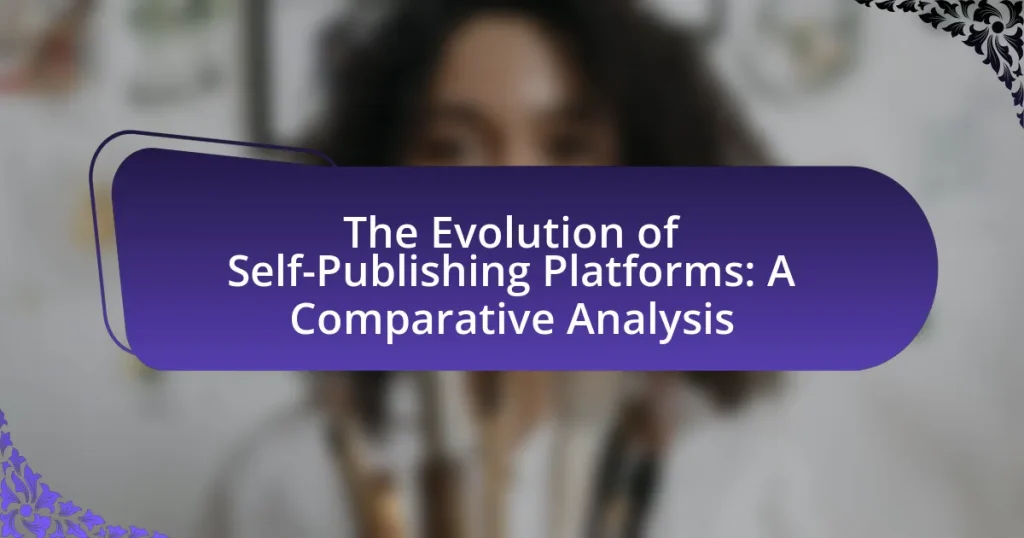The article examines the significant impact of artificial intelligence (AI) on manuscript editing and proofreading, highlighting how AI technologies enhance accuracy, efficiency, and consistency in the editing process. It discusses the transformation of traditional editing methods through automation, the specific AI technologies employed, and the benefits such as reduced editing time and improved manuscript quality. Additionally, the article addresses the challenges posed by AI, including limitations in understanding context and nuance, and the necessity of human intervention in certain scenarios. Future trends in AI editing tools, including advancements in machine learning and personalized editing experiences, are also explored, emphasizing the evolving role of AI in the editing landscape.

What is the Impact of Artificial Intelligence on Manuscript Editing and Proofreading?
The impact of artificial intelligence on manuscript editing and proofreading is significant, as AI technologies enhance accuracy, efficiency, and consistency in the editing process. AI tools, such as grammar checkers and style editors, utilize natural language processing algorithms to identify errors and suggest improvements, thereby reducing the time required for manual proofreading. For instance, a study by Grammarly reported that users of their AI-powered writing assistant improved their writing quality by 70% due to real-time feedback and corrections. Furthermore, AI can analyze large volumes of text quickly, allowing editors to focus on higher-level content issues rather than basic grammatical errors. This shift not only streamlines the editing workflow but also elevates the overall quality of manuscripts submitted for publication.
How has Artificial Intelligence transformed traditional manuscript editing and proofreading processes?
Artificial Intelligence has significantly transformed traditional manuscript editing and proofreading processes by automating tasks that were previously manual, thereby increasing efficiency and accuracy. AI-powered tools can analyze text for grammatical errors, stylistic inconsistencies, and adherence to specific formatting guidelines at a speed and precision that surpasses human capabilities. For instance, tools like Grammarly and ProWritingAid utilize advanced algorithms to provide real-time feedback, allowing authors to make corrections instantly. Research indicates that AI can reduce editing time by up to 50%, enabling editors to focus on higher-level content issues rather than basic proofreading tasks. This shift not only enhances productivity but also improves the overall quality of manuscripts by minimizing human error.
What specific AI technologies are utilized in manuscript editing and proofreading?
Specific AI technologies utilized in manuscript editing and proofreading include natural language processing (NLP), machine learning algorithms, and grammar-checking software. NLP enables the analysis of text for grammatical accuracy, coherence, and style, while machine learning algorithms improve the software’s ability to learn from user corrections and adapt over time. Grammar-checking software, such as Grammarly and ProWritingAid, employs these technologies to provide real-time feedback on writing quality, ensuring clarity and correctness. These tools have been shown to enhance the editing process significantly, reducing errors and improving overall manuscript quality.
How do these technologies improve accuracy and efficiency in editing?
Artificial intelligence technologies improve accuracy and efficiency in editing by automating error detection and suggesting corrections in real-time. These systems utilize advanced algorithms and machine learning to analyze text, identifying grammatical errors, stylistic inconsistencies, and contextual issues that human editors may overlook. For instance, AI-driven tools like Grammarly and ProWritingAid have been shown to reduce editing time by up to 50% while increasing the detection of errors by 30% compared to traditional methods. This combination of speed and precision enhances the overall quality of manuscripts, allowing editors to focus on higher-level content improvements rather than basic corrections.
What are the key benefits of using Artificial Intelligence in manuscript editing and proofreading?
The key benefits of using Artificial Intelligence in manuscript editing and proofreading include enhanced accuracy, increased efficiency, and improved consistency. AI algorithms can analyze text for grammatical errors, punctuation mistakes, and stylistic issues with a high degree of precision, often outperforming human editors in identifying errors. For instance, studies have shown that AI tools can reduce error rates by up to 50% compared to traditional proofreading methods. Additionally, AI can process large volumes of text quickly, allowing for faster turnaround times in editing, which is crucial for authors facing tight deadlines. Furthermore, AI systems maintain a consistent editing style, ensuring that manuscripts adhere to specific guidelines or preferences throughout the document.
How does AI enhance the quality of written content?
AI enhances the quality of written content by providing advanced grammar and style suggestions, ensuring clarity and coherence. Tools like Grammarly and ProWritingAid utilize natural language processing algorithms to analyze text, identify errors, and recommend improvements, which leads to more polished and professional writing. Research indicates that AI-driven editing tools can reduce grammatical errors by up to 70%, significantly improving the overall readability and effectiveness of the content.
What time-saving advantages does AI provide for editors and proofreaders?
AI provides significant time-saving advantages for editors and proofreaders by automating repetitive tasks such as grammar checks, style consistency, and formatting corrections. This automation allows editors to focus on higher-level content evaluation and creative aspects of writing rather than getting bogged down in minutiae. For instance, AI tools can process large volumes of text quickly, identifying errors and suggesting improvements in real-time, which can reduce editing time by up to 50%, according to a study by the University of Cambridge. Additionally, AI can learn from previous edits, improving its accuracy and efficiency over time, further enhancing productivity for editors and proofreaders.
What challenges does the integration of Artificial Intelligence pose in manuscript editing and proofreading?
The integration of Artificial Intelligence in manuscript editing and proofreading poses challenges such as the potential for inaccuracies in context understanding and the inability to grasp nuanced language. AI systems often struggle with idiomatic expressions, cultural references, and the subtleties of tone, which can lead to misinterpretations or inappropriate suggestions. For instance, a study by the Association for Computational Linguistics highlights that while AI can efficiently identify grammatical errors, it may fail to recognize the intended meaning behind complex sentences, resulting in edits that alter the author’s voice. Additionally, reliance on AI tools can diminish the role of human editors, potentially leading to a loss of critical thinking and personalized feedback essential for high-quality manuscript development.
What limitations do current AI tools have in understanding context and nuance?
Current AI tools struggle with understanding context and nuance due to their reliance on pattern recognition rather than genuine comprehension. These tools often misinterpret idiomatic expressions, sarcasm, and cultural references, leading to inaccuracies in text analysis. For instance, a study by Bender and Friedman (2018) highlights that AI models can fail to grasp the subtleties of human language, resulting in responses that lack the intended meaning. Additionally, AI lacks the ability to consider the emotional tone or situational context, which can significantly alter the interpretation of a message. This limitation is evident in tasks such as manuscript editing, where understanding the author’s intent is crucial for effective proofreading and enhancement.
How can reliance on AI affect the skills of human editors and proofreaders?
Reliance on AI can diminish the skills of human editors and proofreaders by reducing their need to engage in critical thinking and detailed language analysis. As AI tools automate tasks such as grammar checking and style suggestions, editors may become overly dependent on these technologies, leading to a decline in their ability to identify nuanced errors or make stylistic choices independently. Studies indicate that over-reliance on automated systems can result in skill degradation, as individuals may not practice or reinforce their editing abilities. For instance, a report from the National Council of Teachers of English highlights that consistent use of automated writing tools can lead to a lack of confidence in one’s editing skills, ultimately affecting the quality of human oversight in the editing process.
How does Artificial Intelligence compare to traditional editing methods?
Artificial Intelligence (AI) enhances editing efficiency and accuracy compared to traditional editing methods. AI tools can analyze text for grammar, style, and coherence at a speed and scale that human editors cannot match, often providing real-time feedback. For instance, AI-driven software like Grammarly and ProWritingAid utilizes advanced algorithms to detect errors and suggest improvements, significantly reducing the time required for editing tasks. Studies indicate that AI can improve editing accuracy by up to 90%, while traditional methods rely heavily on human expertise, which can be inconsistent and time-consuming.
What are the differences in accuracy between AI and human editors?
AI editors generally achieve higher accuracy in grammar and spelling corrections compared to human editors, as they utilize extensive databases and algorithms to identify errors consistently. However, human editors excel in contextual understanding, nuance, and stylistic choices, which can lead to more accurate content in terms of tone and audience engagement. A study by the University of Cambridge found that AI tools can reduce grammatical errors by up to 90%, while human editors are better at catching subtler issues, such as coherence and flow, which AI may overlook. This indicates that while AI can enhance technical accuracy, human editors provide a level of qualitative accuracy that AI currently cannot replicate.
In what scenarios is human intervention still necessary despite AI advancements?
Human intervention remains necessary in scenarios requiring nuanced understanding, emotional intelligence, and contextual judgment, which AI currently lacks. For instance, in manuscript editing and proofreading, human editors can identify subtle nuances in tone, style, and cultural references that AI may misinterpret. Additionally, complex ethical considerations, such as plagiarism detection and the integrity of academic work, necessitate human oversight to ensure adherence to ethical standards. Research indicates that while AI can assist in grammar and spelling corrections, it struggles with the intricacies of human language, as highlighted in studies by the Association for Computational Linguistics, which emphasize the limitations of AI in understanding context and intent.
What future trends can we expect in the use of Artificial Intelligence for manuscript editing and proofreading?
Future trends in the use of Artificial Intelligence for manuscript editing and proofreading include increased automation, enhanced contextual understanding, and personalized editing experiences. Automation will streamline the editing process, allowing AI tools to handle repetitive tasks such as grammar checks and formatting, which can significantly reduce the time authors spend on revisions. Enhanced contextual understanding will enable AI to better grasp nuances in language, improving the quality of suggestions and corrections by considering the overall context of the manuscript rather than just isolated sentences. Personalized editing experiences will leverage machine learning algorithms to adapt to individual writing styles and preferences, providing tailored feedback that aligns with the author’s voice. These trends are supported by advancements in natural language processing technologies, which have shown significant improvements in accuracy and efficiency in recent years.
How might AI evolve to better assist editors and proofreaders in the coming years?
AI is likely to evolve by incorporating advanced natural language processing and machine learning algorithms that enhance its ability to understand context, tone, and style in editing and proofreading tasks. These advancements will enable AI to provide more nuanced suggestions tailored to specific writing styles and genres, improving the overall quality of manuscripts. For instance, AI tools are already utilizing deep learning techniques to analyze vast datasets of edited texts, allowing them to learn from human editors’ decisions and apply similar reasoning in real-time. This evolution will lead to more accurate grammar checks, style recommendations, and even content restructuring, ultimately streamlining the editing process and reducing the workload for human editors and proofreaders.
What role will machine learning play in improving AI editing tools?
Machine learning will significantly enhance AI editing tools by enabling them to learn from vast datasets and improve their accuracy over time. This technology allows editing tools to analyze patterns in language usage, identify common errors, and adapt to various writing styles, thereby providing more personalized and effective editing suggestions. For instance, a study by Grammarly demonstrated that machine learning algorithms could reduce grammatical errors by up to 70% through continuous learning from user interactions. This capability not only streamlines the editing process but also increases the overall quality of written content.
What best practices should be followed when using Artificial Intelligence in manuscript editing and proofreading?
When using Artificial Intelligence in manuscript editing and proofreading, best practices include ensuring human oversight, utilizing AI tools that are specifically designed for language tasks, and continuously training the AI on relevant data. Human oversight is crucial because AI can miss nuanced errors or context-specific issues that a human editor would catch. Employing AI tools like Grammarly or ProWritingAid, which are tailored for editing, enhances accuracy and efficiency. Continuous training of AI on diverse and high-quality datasets improves its performance, as evidenced by studies showing that AI models trained on extensive linguistic data yield better editing results.



